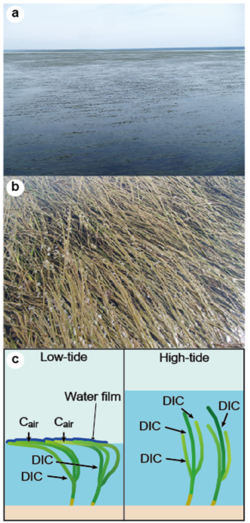Title: Radiocarbon isotopic evidence for assimilation of atmospheric CO2 by the seagrass Zostera marina
Authors: Kenta WATANABE and Tomohiro KUWAE (PARI)
Journal: Biogeosciences 12(20): 6251-6258
Kenta WATANABE and Tomohiro KUWAE (Port and Airport Research Institute; PARI) report that the seagrass Zostera marina assimiilates significant amount of atmospheric carbon dioxide (CO2) in a shallow coastal system in Japan. The research article was published in the scientific journal "Biogeosciences" (Journal Site).
Submerged aquatic vegetation takes up water-column dissolved inorganic carbon (DIC) as a carbon source. Marine macrophytes may also use atmospheric CO2 when exposed to air during low tide; however, use of atmospheric CO2 has never been quantitatively evaluated.
Our empirical study demonstrates the quantitative evidence of assimilating atmospheric modern CO2 by the seagrass Z. marina, by analyzing the radiocarbon isotope concentrations (Δ14C) of both the seagrass and two carbon sources (atmospheric vs water column) in a brackish lagoon. The results show that the seagrass assimilated 0-40% (mean, 17%) of its carbon source as atmospheric CO2 (Fig. 1).
CO2 exchange between the air and water would occur at the very thin film of water over the air-exposed seagrass leaves (Fig. 2). Our findings offers better understanding of the role og seagrass meadows in global coastal carbon dynamics.

Fig. 1 (a) Radiocarbon concentration (Δ14C) of the seagrass is significantly higher than that of water-column DIC, indicating that the seagrass assimilates high-Δ14C carbon source (atmospheric CO2). (b) A carbon-source mixing model shows that the seagrass assimilated 0-40% (mean, 17%) of its carbon source as atmospheric CO2.

Fig. 2 (a) Distant and (b) close up view os the seagrass leaves exposed to the air during low tide in Furen Lagoon, Japan. (c) Conceptual diagram of the uptake of atmospheric CO2 across the surface-water film on the seagrass leaves during low tide (left), and the uptake of DIC during high tide (right).
Title: Radiocarbon isotopic evidence for assimilation of atmospheric CO2 by the seagrass Zostera marina
Authors: Kenta WATANABE and Tomohiro KUWAE (PARI)
Journal: Biogeosciences 12(20): 6251-6258